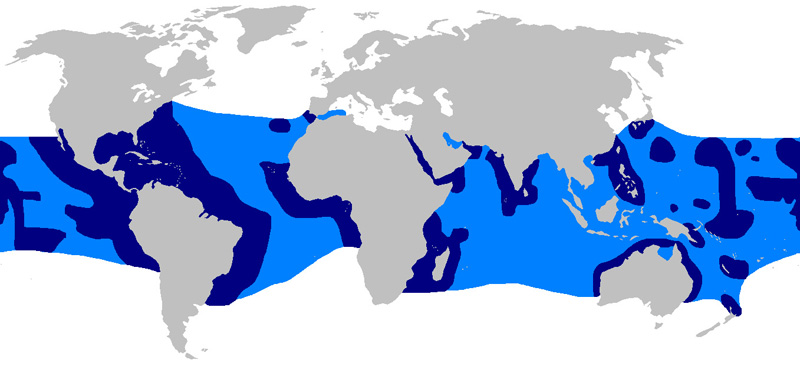
Description de l'animal
The Silky shark (Carcharhinus falciformis), often referred to as the "silk shark" due to its exceptionally smooth skin texture, is a fascinating and widely distributed species within the shark family Carcharhinidae. This pelagic shark is found in the tropical and subtropical waters of the Atlantic, Pacific, and Indian Oceans, typically roaming the deep offshore waters, though it occasionally ventures closer to shore, especially around oceanic islands.Characterized by its slender and streamlined body, the Silky shark can reach a length of up to 3.5 meters (11.5 feet), with females generally growing larger than males. Its name, "falciformis," is derived from Latin, meaning "sickle-shaped," a nod to its distinctively long, slender, and curved pectoral fins, which resemble the blade of a sickle. This unique fin shape aids in its agility and speed, making it an adept swimmer capable of sudden bursts of speed to catch prey.
The dorsal surface of the Silky shark is a dark, dusky blue to gray color, seamlessly transitioning to a white or lighter underside. This countershading is a common feature in many marine animals, serving as camouflage against predators and prey by blending with the ocean depths when viewed from above and with the surface light when viewed from below.
Silky sharks have a relatively large, rounded snout and large, oval eyes equipped with nictitating membranes—a protective third eyelid—which shields their eyes while feeding. Their mouths house several rows of sharp, serrated teeth in both jaws, ideal for gripping slippery prey such as fish and squid, which constitute the majority of their diet.
Social creatures, Silky sharks often form large schools, especially during their juvenile stages, providing some protection against predators. These schools can sometimes include hundreds of individuals and are particularly common around oceanic islands and seamounts, where food sources are abundant.
Reproduction in Silky sharks is viviparous, meaning they give birth to live young after a gestation period of about 12 months. The young sharks are born fully developed and are independent from birth, measuring between 60 to 85 centimeters (24 to 33 inches) in length. Females typically give birth to litters of 2 to 14 pups, with the size of the litter often correlating with the size of the mother.
Despite their impressive speed and agility, Silky sharks face significant threats from human activities, particularly from commercial fishing. They are highly valued for their fins, which are sought after for shark fin soup, leading to their capture in high numbers both as target species and as bycatch in tuna and swordfish fisheries. This has resulted in a significant decline in their populations globally, prompting the International Union for Conservation of Nature (IUCN) to classify the Silky shark as Vulnerable to extinction.
Conservation efforts are underway to protect this species, including regulations on fishing practices and the establishment of marine protected areas. The survival of the Silky shark is crucial not only for the health of marine ecosystems but also for maintaining the balance of the ocean's complex food webs.
Carte de répartition

Animaux similaires
Nouvelles photos d'animaux
Top 10 des animaux
- Dolphin gull (Leucophaeus scoresbii)
- Diana monkey (Cercopithecus diana)
- Moustached guenon (Cercopithecus cephus)
- Galápagos tortoise (Geochelone nigra complex)
- Japanese macaque (Macaca fuscata)
- Russian tortoise (Testudo horsfieldii)
- Stone loach (Barbatula barbatula)
- Greek tortoise (Testudo graeca)
- Common flying dragon (Draco volans)
- Vendace (Coregonus albula)


